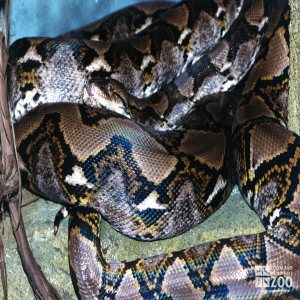Reticulated Python
[Python reticulatus]

The Reticulated Python is the world's longest snake, but not the heaviest. One specimen was 33 feet long and weighed over 300 pounds. A more usual length is 25 feet with some larger specimens reaching 30 feet.The beautiful markings on the skin of this snake make it almost impossible to pick it out in the leaf litter of the forest floor. Its favorite hunting technique is to just lie in wait for some animal to pass by. When its prey comes within reach it seizes it with a lightning strike, and holds on with a vice-like grip. It then coils its body around the animal and squeezes so that the animal can no longer breathe, and as a result dies. The prey is then eaten. While stories about this python eating large prey such as wild boar, adult deer and full grown leopards are true, its more usual prey are much smaller: rats, rabbits, squirrels, birds, monkeys, etc. These are much easier to overpower, and their consumption does not inhibit the snake from ordinary movements. When very large prey are consumed the python may be almost immobile for several days.After laying her eggs in a hole or cave the female abandons them to hatch by themselves.
Location: Animals Formerly at Zoo
Share:
Range
The range of the reticulated python is India and Indochina.
Habitat
Reticulated Pythons inhabit rainforests.
Conservation Status
Least ConcernPrimary Threats
Gestation
Incubation: 60 to 80 days
Litter
They lay up to 100 eggs in a clutch.
Behavior
The beautiful markings on the skin of the reticulated python make it almost impossible to pick it out in the leaf litter of the forest floor. Its favorite hunting technique is to just lie in wait for some animal to pass by. When its prey comes within reach it seizes it with a lightning strike, and holds on with a vice-like grip. It then coils its body around the animal and squeezes so that the animal can no longer breathe, and as a result dies. The prey is then eaten. While stories about this python eating large prey such as wild boar, adult deer and full grown leopards are true, its more usual prey are much smaller: rates, rabbits, squirrels, birds, monkeys, etc. These are much easier to overpower, and their consumption does not inhibit the snake from ordinary movements. When very large prey are consumed the python may be almost immobile for several days, and cannot defend itself from its enemies, such as tigers, bears or leopards.
Reproduction
The eggs of the reticulated python are large, oval and soft-shelled. After laying her eggs in a hole or cave the female abandons them to hatch by themselves. Hatchlings may measure from 22 to 30 inches. Growth is fairly rapid during the first few years, then slows with advancing years.
Wild Diet
The diet of the reticulated python in the wild is primarily warm-blooded vertebrates.
Zoo Diet
Mice, rats, chickens
